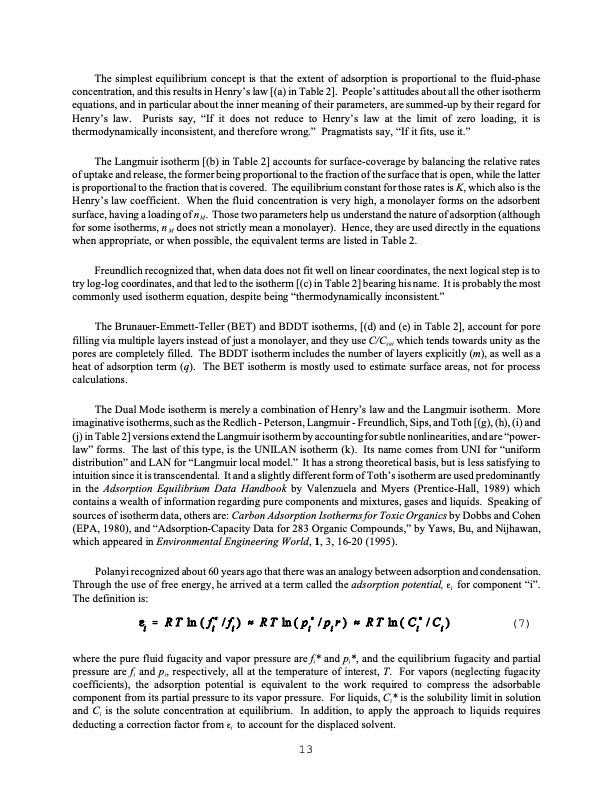
PDF Publication Title:
Text from PDF Page: 015
The simplest equilibrium concept is that the extent of adsorption is proportional to the fluid-phase concentration, and this results in Henry’s law [(a) in Table 2]. People’s attitudes about all the other isotherm equations, and in particular about the inner meaning of their parameters, are summed-up by their regard for Henry’s law. Purists say, “If it does not reduce to Henry’s law at the limit of zero loading, it is thermodynamically inconsistent, and therefore wrong.” Pragmatists say, “If it fits, use it.” The Langmuir isotherm [(b) in Table 2] accounts for surface-coverage by balancing the relative rates of uptake and release, the former being proportional to the fraction of the surface that is open, while the latter is proportional to the fraction that is covered. The equilibrium constant for those rates is K, which also is the Henry’s law coefficient. When the fluid concentration is very high, a monolayer forms on the adsorbent surface, having a loading of n M . Those two parameters help us understand the nature of adsorption (although for some isotherms, n M does not strictly mean a monolayer). Hence, they are used directly in the equations when appropriate, or when possible, the equivalent terms are listed in Table 2. Freundlich recognized that, when data does not fit well on linear coordinates, the next logical step is to try log-log coordinates, and that led to the isotherm [(c) in Table 2] bearing his name. It is probably the most commonly used isotherm equation, despite being “thermodynamically inconsistent.” The Brunauer-Emmett-Teller (BET) and BDDT isotherms, [(d) and (e) in Table 2], account for pore filling via multiple layers instead of just a monolayer, and they use C/Csat which tends towards unity as the pores are completely filled. The BDDT isotherm includes the number of layers explicitly (m), as well as a heat of adsorption term (q). The BET isotherm is mostly used to estimate surface areas, not for process calculations. The Dual Mode isotherm is merely a combination of Henry’s law and the Langmuir isotherm. More imaginative isotherms, such as the Redlich - Peterson, Langmuir - Freundlich, Sips, and Toth [(g), (h), (i) and (j) in Table 2] versions extend the Langmuir isotherm by accounting for subtle nonlinearities, and are “power- law” forms. The last of this type, is the UNILAN isotherm (k). Its name comes from UNI for “uniform distribution” and LAN for “Langmuir local model.” It has a strong theoretical basis, but is less satisfying to intuition since it is transcendental. It and a slightly different form of Toth’s isotherm are used predominantly in the Adsorption Equilibrium Data Handbook by Valenzuela and Myers (Prentice-Hall, 1989) which contains a wealth of information regarding pure components and mixtures, gases and liquids. Speaking of sources of isotherm data, others are: Carbon Adsorption Isotherms for Toxic Organics by Dobbs and Cohen (EPA, 1980), and “Adsorption-Capacity Data for 283 Organic Compounds,” by Yaws, Bu, and Nijhawan, which appeared in Environmental Engineering World, 1, 3, 16-20 (1995). Polanyi recognized about 60 years ago that there was an analogy between adsorption and condensation. Through the use of free energy, he arrived at a term called the adsorption potential, gi for component “i”. The definition is: (7) where the pure fluid fugacity and vapor pressure are fi* and pi*, and the equilibrium fugacity and partial pressure are fi and pi, respectively, all at the temperature of interest, T. For vapors (neglecting fugacity coefficients), the adsorption potential is equivalent to the work required to compress the adsorbable component from its partial pressure to its vapor pressure. For liquids, Ci* is the solubility limit in solution and Ci is the solute concentration at equilibrium. In addition, to apply the approach to liquids requires deducting a correction factor from gi to account for the displaced solvent. 13PDF Image | ADSORBENT SELECTION

PDF Search Title:
ADSORBENT SELECTIONOriginal File Name Searched:
AdsorbentSel1B.pdfDIY PDF Search: Google It | Yahoo | Bing
CO2 Organic Rankine Cycle Experimenter Platform The supercritical CO2 phase change system is both a heat pump and organic rankine cycle which can be used for those purposes and as a supercritical extractor for advanced subcritical and supercritical extraction technology. Uses include producing nanoparticles, precious metal CO2 extraction, lithium battery recycling, and other applications... More Info
Heat Pumps CO2 ORC Heat Pump System Platform More Info
| CONTACT TEL: 608-238-6001 Email: greg@infinityturbine.com | RSS | AMP |